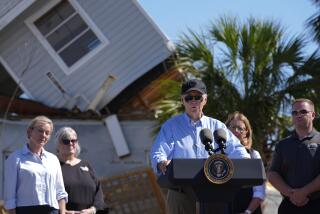A Massive Response to a Massive Need
WASHINGTON — Government and private relief agencies scrambled Tuesday to cope with a worsening humanitarian crisis in Gulf Coast cities and towns devastated by Hurricane Katrina, and President Bush decided to cut short his Texas vacation and return to the capital to oversee the relief effort.
Officials at a host of federal agencies -- including the Federal Emergency Management Agency, Defense Department and Coast Guard -- rushed thousands of rescue workers, emergency medical personnel and disaster recovery experts to Louisiana, Mississippi and Alabama, along with mountains of food, water, tents, medical supplies and other equipment.
With floodwaters still rising in New Orleans and other cities, the American Red Cross said its effort -- which included caring for about 70,000 people in more than 200 shelters stretching in an arc from Florida to Texas and as far north as Tennessee -- may be its biggest ever inside the United States.
“We have an American refugee situation on our hands,” said Laura Howe, a Red Cross spokeswoman working in Birmingham, Ala. “We have a mass migration of people who are homeless. It is an incredible thing to see and experience, and I don’t think any of us in our lifetimes ever thought we would see anything like this.”
The need for shelter alone threatened to overwhelm the relief effort. Emergency housing facilities in the three states directly in Katrina’s path, as well as shelters as far away as Memphis, Tenn., and Dallas, were already at or near capacity, Howe said, with more people arriving by the hour. Thousands who had evacuated early and moved to hotels outside the storm area were descending on public shelters after running out of money. Thousands more who tried to ride out the hurricane were also seeking shelter.
“We have a new wave of evacuees coming out simply because they’re homeless,” Howe said. “They have nowhere else to go.”
Ordinarily, she said, Red Cross shelters begin to empty within days after a natural disaster strikes, but that may not be true this time. “We expect to have people in these shelters for quite some time -- for weeks.”
The Salvation Army was distributing about 150,000 meals a day from locations in Mobile, Ala., Jackson, Miss., and Baton Rouge, La., along with 120,000 meals a day dispensed from six mobile kitchens on 54-foot semi-trailers, Salvation Army official Mark Jones said.
Jones, who lived through four hurricanes in Florida, said he had never seen anything like the destruction wrought by Katrina. “It’s catastrophic,” he said.
For officials such as Jones, Howe and their government counterparts, the scale of the need was measured in mega-numbers -- millions of the military field rations known as Meals Ready to Eat, tens of thousands of gallons of water, tons of ice and scores of rescue boats, planes and emergency vehicles converging on New Orleans and other battered cities and towns.
For others, however, the hurricane’s impact was measured one friend or relative at a time. Struggling with fear and uncertainty, Americans from coast to coast groped for information about individuals who had vanished behind the wind and rain of the storm.
That personal dimension was reflected in a spate of messages posted on websites such as Craigslist, a nationwide network of community bulletin boards.
“This is Loretta, looking for my son in New Orleans, I cannot get in touch with him.... I need to know if he is okay,” one user wrote, adding that her son “has broken foot, lives at Crossroads Apartments on Cleary near Veterans Blvd. The apartments are in Metairie, La. ... Love You and Praying for you. very worried.”
Another said: “Looking for an elderly woman ... born June 14,1919. She lived at 729 Gattier New Orleans, LA. Last contact was at 10 am yesterday August 29, 2005. At that time she still hadn’t left the home if anyone has any info. We would also like to know what this street is like. Please call....”
And another: “I got out of New Orleans on Sunday and am safe in Little Rock, Ark staying with very hospitable hosts who were perfect strangers to me two days ago. Me and my friend ... drove a two door Nissan Sentra with three 70 pound dogs and a cat. It was pretty crowded but at least we’re safe. I’m really worried about my friends without vehicles.... Let me know if you’re ok or anyone who knows their whereabouts.
“My heart goes out to everyone trapped in my city.”
In Washington, an interagency task force will oversee the expanding federal response to Katrina under the direction of the president, who was to fly back to Washington from his Texas ranch today.
“The president’s preference is to manage the response efforts from Washington,” White House Press Secretary Scott McClellan said. “And it’s going to require a long and sustained effort on behalf of all federal agencies working closely with state and local officials to help people recover.”
Earlier in Bush’s monthlong vacation, White House officials had brushed aside criticism that he was absent from the capital during a critical phase of the war in Iraq. Communications make it possible for a president to manage such problems without being present in the capital, they said.
McClellan said Bush would tour the disaster area, possibly later this week.
At a previously scheduled speech near San Diego commemorating the victory over Japan that ended World War II, Bush said: “This morning our hearts and prayers are with our fellow citizens along the Gulf Coast who have suffered so much from Hurricane Katrina. These are trying times for the people of these communities.”
Appealing for public support of the relief effort, the president said, “The good folks in Louisiana and Mississippi and Alabama and other affected areas are going to need the help and compassion and prayers of our fellow citizens.”
Bush returned to his ranch from San Diego on Tuesday night. He was scheduled to depart Texas for Washington at midmorning and was to preside over a meeting of federal officials responding to the crisis later in the day.
Before Katrina came ashore, FEMA deployed 23 disaster medical assistance teams to staging areas in Alabama, Tennessee, Texas and Louisiana, and Tuesday they moved into the areas affected by the storm. The teams, trained to handle trauma, pediatrics, surgery and mental health problems, brought truckloads of medical supplies with them.
Two veterinary medical assistance teams, which can provide care for pets, also were sent.
FEMA alone had 500 trucks of ice, 500 trucks of water and 350 trucks of military meals available for distribution over the next 10 days.
Seven urban search and rescue task forces and two incident support teams were moved into the area from their home bases in Florida, Indiana, Ohio, Maryland, Missouri, Tennessee, Texas and Virginia.
At the same time, about 40 Coast Guard aircraft from units along the Eastern Seaboard, along with about 30 patrol boats, cutters and other vessels, moved in on an arc stretching from Jacksonville, Fla., to Houston and began conducting search, rescue and humanitarian aid operations, assessing the damage and rebuilding waterways.
The Department of Health and Human Services worked to ensure that medical supplies were available to patients evacuated from hurricane-damaged hospitals and to warn survivors of the dangers posed by gasoline-powered electrical generators, spoiled food and other things. The department also sought to prepare for a possible infestation of disease-carrying mosquitoes in flooded New Orleans.
“In terms of what we are seeing right now, the priorities are access to water, food, shelter, medical care and security,” said Tom Sinks, acting director of the National Center for Environmental Health, part of the Centers for Disease Control and Prevention. “That’s what we put at the top of the list.”
In many cases, federal health authorities were playing a supporting role to their state and local counterparts, but Washington’s tasks are likely to grow rapidly.
The federal Health department had 27 pallets of medical supplies airlifted to Louisiana, spokeswoman Christina Pearson said. “A lot of it is basic first-aid material, such as bandages, ice packs, suture kits, sterile gloves, stethoscopes, blood-pressure kits and portable oxygen,” she said. “A lot of patients have had to be evacuated from hospitals.”
The materials are a down payment. The Gulf Coast has taken a direct hit to almost every aspect of its infrastructure, including hospitals, highways, schools, clinics and medical offices.
How deep the damage may go was suggested by Tony Harris of the Alabama Department of Transportation. Harris described his agency’s struggle to pump out Wallace Tunnel, a section of Interstate 10 that dips under the mouth of the Mobile River. Interstate 10 is a major east-west thoroughfare across Louisiana, Alabama, Mississippi and into Florida.
As Harris outlined the efforts by fire departments and others to deal with the situation, he learned of another problem: A barge had broken loose from its moorings and crashed into Mobile’s Cochran Bridge. The damage had yet to be determined.
Times staff writers Ricardo Alonso-Zaldivar, Edwin Chen and John Hendren contributed to this report.
More to Read
Sign up for Essential California
The most important California stories and recommendations in your inbox every morning.
You may occasionally receive promotional content from the Los Angeles Times.











